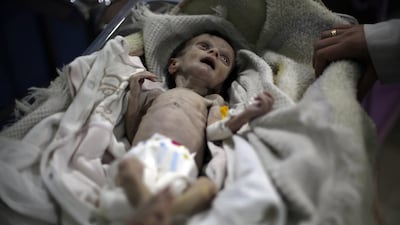Beirut // Photos of a child who starved to death in the eastern suburbs of Damascus have brought renewed attention to the humanitarian crisis caused by Syria’s civil war.
The pictures of Sahar Dofdaa, a one-month-old baby who weighed less than two kilograms and died on Saturday, were published on Monday by Agence France-Presse.
The girl died from severe malnutrition and AFP reported her mother also suffers from malnutrition. The family lives in Hamouriya, one of the neighbourhoods in Damascus’s suburbs known collectively as Eastern Ghouta, where more than 350,000 people find themselves in worsening conditions.
“Mothers can't breastfeed infants because they themselves can hardly stand on their feet,” said Siraj, a 21-year-old student living in Eastern Ghouta. “There is dire need for children’s milk. Some mothers don't eat; they save the food for their children. Others can't find anything to eat for themselves or for their children.”
Rebels and civilians in Eastern Ghouta have been largely surrounded by the Syrian government since 2012, but residents said the area has been under intensified siege after the government’s forces launched an offensive in adjacent neighbourhoods of Qaboun and Barzeh in April, cutting off tunnels that had been used to bring supplies into Eastern Ghouta. The only major above-ground crossing between government-held areas and Eastern Ghouta was also shut down in April.
____________
Read more:
'Just about money': Iran recruits Afghans for Syria fight
US-led coalition denies deadly Syria strikes in Deir Ezzor
____________
Residents blamed the government for the humanitarian crisis, but also pointed fingers at rebel groups and merchants.
“Ghouta is denied all requirements of life. It is true that you can find everything, but the prices are beyond imagination,” Siraj said.
"Sometimes I wait four hours to get a pack of bread, and we pay 1100 Syrian pounds [Dh44] for each pack," he told The National. "The income of a worker in Ghouta is 1100 Syrian pounds a day. So, if you have four or five kids, you can feed them nothing more than bread."
One local political activist estimated that 70 per cent of Eastern Ghouta’s residents are unemployed.
The siege in Eastern Ghouta is not the first example of severe malnutrition and starvation in Syria’s six-year-old civil war. Both the government’s forces and rebel groups have been accused of using siege tactics that have led to severe malnutrition and starvation, and there have been scores of reports of death from starvation in recent years.
"This happens when the population depends on aid," said Ingy Sedky, the spokeswoman for the International Committee of the Red Cross in Syria. “The last time we managed to reach the area was September.”
Ms Sedky said the delivery of aid was intended to provide food for 25,000 people for one month.
“That for sure is not enough, and because convoys to Eastern Ghouta have not been regular, the situation, especially for children, is deteriorating,” Ms Sedky said.
The United Nations Office of Humanitarian Affairs estimated that as of September, there were approximately 420,000 Syrians living in 10 besieged areas.
The Washington-based Syria Institute, which releases a quarterly report detailing sieges in the country, puts the number living under siege at closer to one million, and the number of communities living under siege at 34. The two groups often disagree when rating the severity of a siege in a particular area, with the UN often using the term “hard-to-reach” instead of “besieged.”
____________
Read more:
ISIL 'executed' 116 in Syria town revenge campaign
Syria's deadliest month of 2017 claims 3,000 lives
____________
The UNOCHA also reported that more than 3 million Syrians live in “hard-to-reach” areas where international organizations face difficulties delivering aid.
The issue drew widespread attention last year after Syrian government forces, including Lebanese Hizbollah, were accused of starving residents of the rebel-held town of Madaya, near the Syrian-Lebanese border. More than 60 deaths from starvation were reported in Madaya alone.
The Syrian government in turn accused rebel groups of attempting to forcibly starve four towns in near the northern Syrian city of Aleppo. The UN also reported possible deaths from starvation in Deir Ezzor, in eastern Syria, in 2016. In 2014, dramatic photos of thousands of people queuing for food handouts in Yarmouk, a largely Palestinian neighbourhood in southern Damascus, drew attention to the ongoing humanitarian crisis in that area. More than 100 people were reported to have starved to death in the neighbourhood at the time.
In many cases, local deals have been struck between warring parties to help alleviate civilian suffering. However, most have broken down, including a high-profile agreement involving Madaya, which remains under siege.
East Ghouta is one of the four “de-escalation” zones the Russian government has helped broker inside the country this year, though fighting continues in the area and has hampered aid delivery.
Still, deals brokered between rebel groups and the government have helped reduce the number of people living in “hard-to-reach” areas in recent months, though some of those deals have been criticised as amounting to forced displacement.
Meanwhile, those under siege can do little but wait and hope.
“The besieged is someone who doesn't believe,” said Samira, a 35-year-old resident of Al Fuaa, a town in northern Idlib province besieged by rebels for two years. “I'm not talking about belief in religion, but belief in humanity. Even if we are animals, it is not fair to be besieged this way, to be denied life and left to die of famine and despair.”
“We watch the news hour after hour. We normally look for anything that fills the belly, trying to forget about tomorrow, which could bring death,” she said. “We dream of living like people around us in the outside world.”
* Additional reporting by Agence France-Presse

